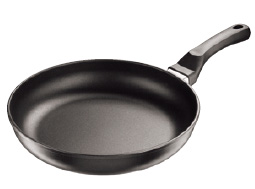Whether you are a run a restaurant or your home’s kitchen, what health score would you give the food in that kitchen?
It’s an important factor to consider in light of this article which states,
“…more than 7 in 10 consumers said they are trying to eat healthier at restaurants than they did two years ago. Women are more likely to say they are eating healthier at restaurants than men, at 75 percent and 66 percent reporting such, respectively. Additionally, three-fourths of consumers said healthy menu options are an important factor when choosing a restaurant, with 80 percent of women and 71 percent of men reporting this.”
Knowing that consumers strongly consider healthy options in their restaurant decisions and that people also seriously consider the same health aspects in their own kitchen, it is prudent to contemplate how we can make all of our kitchens healthier.
Below are 4 steps to a healthier kitchen – just enough to get you started in the right direction.
1) Lower the heat on nonstick cookware
 High temperatures easily cause the nonstick lining on cookware to release fumes that contain PFCs (perfluorocarbons). PFCs are linked to liver damage and developmental problems. Use wooden utensils in your nonstick pans instead of metal utensils, which could lead you to ingest the PFCs in the nonstick lining. As an alternative to nonstick, try using cast iron.
High temperatures easily cause the nonstick lining on cookware to release fumes that contain PFCs (perfluorocarbons). PFCs are linked to liver damage and developmental problems. Use wooden utensils in your nonstick pans instead of metal utensils, which could lead you to ingest the PFCs in the nonstick lining. As an alternative to nonstick, try using cast iron.
2) Remember what’s fishy about fish
Fish can be a robust source of omega-3s and a delicious protein to serve for dinner, but some fish have become increasingly infamous for their mercury levels. In high doses, mercury can harm the nervous system, heart, lungs, kidneys, and immune system (and even low levels can affect the brains of young children). Use this handy guide to determine which fish are healthiest (and which are unhealthiest).
3) Trim the fat, don’t chew it
Meat and dairy are excellent options for getting protein and other nutrients. But animal fat can contain dioxins – chemicals that are stored in animal fat and have cancer-causing properties. More than 90% of your exposure to dioxins is through food, mostly meat, dairy, fish and shellfish. To help reduce dioxin exposure, select lean meat and low-fat dairy products. Take the time to skin chicken or trim the fat from meat before cooking it.
4) Learn the dirty dozen
Do you know which fruits and vegetables are linked with higher levels of pesticide? Pesticide exposure is linked with diseases of the nervous system and problems with cell growth, including reproductive problems and some cancers.
Keep a list on hand of “the Dirty Dozen”—the 12 fruits and vegetables the Environmental Working Group has identified as having the most pesticide residues to reduce pesticide exposure. Remember though, even conventionally grown fruits and vegetables deliver important vitamins and other nutrients. So, if buying organic is not an option for you, don’t sweat it: it is more important to eat fruits and vegetables than to shun them because they’re conventionally grown.
What steps will you take to make a healthier kitchen? Let us know in a comment below.


 ving naturally (regular walking or bike riding)
ving naturally (regular walking or bike riding)